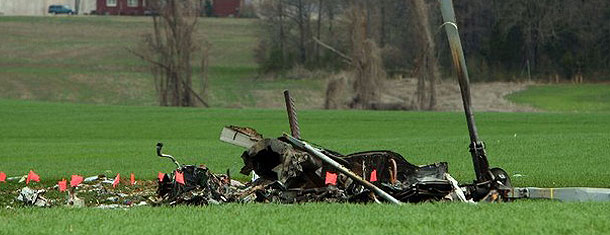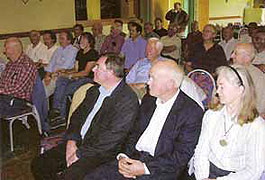
Are we making a good fist of teaching people to fly helicopters? Or are we instilling in them habits that are more likely to kill them, than save their lives?
The question is moot, but there's a body of empirical evidence mostly in the form of accident wreckage - to support the idea that we're not getting it absolutely right.
Accident investigator Richard Mornington-Sanford believes there are a number of things in the training syllabus that need to be changed to reduce the number of helicopter accidents. Some are contentious, some less so, but all of them need to be looked at.
Richard’s Safety Day for club members proved to be extremely popular, with 47 members traveling to Sywell for what was a very useful and possibly life-saving presentation.
Richard, himself an HCGB member, is a high-time pilot, a flying instructor, a helicopter engineer and an accident investigator, who runs the Robinson Safety Courses in the UK. He has been deeply affected by some of the accident scenes he has attended, and he gave his services free to help club members improve the knowledge that helps them fly safely.
Few people are in a better position than Richard to evaluate what we're doing right and wrong.
He began by telling us that 58 percent of people believe they have above-average intelligence – a manifestation of the human tendency to harbour optimistic opinions of our own ability. Pilots, he said, believe they are less likely than their peers to run into inadvertent IMC or other problems, and better able than most to handle it if they do. This optimism leads to risk-taking, accidents and death.
Our instrument flying skills are, however, inadequate. Tests in Florida showed that students lasted for an average of 176 seconds in IMC before entering a graveyard spiral – and that was in fixed-wing aircraft! In unstable helicopters, death would come much sooner.
Under the JARs, PPL(H) students must undergo five hours of instrument training. ”This is a simple matter of giving people enough knowledge to kill themselves."
Richard said. “Personally I refuse to teach PPL students instrument flying, and I believe the practice should be stopped immediately.” Spatial disorientation resulting from a misguided attempt to fly on instruments is usually fatal because it leads to a high-energy impact.
Richard said. “Loose sight of the ground and you loose your life. That's the simple fact. Human balance and orientation systems were designed to work on the ground, not in the air. But our instincts are so strong that pilots who experience spatial disorientation will sometimes believe the controls had jammed - they were physically unable to move their own arms, such was the power of the conflict in their minds.”
Not only do we teach instrument flying, he said, but we teach students that the right thing to do is to attempt a 180 degree turn out of IMC. “So you take an aircraft in a reasonably stable position for a helicopter, and deliberately put it in an unstable position by turning.”
Richard said. “We teach you to do it, we examine you on it, we tell you you've passed the examination of your ability to do it, then we say that if you do it you'll kill yourself. The number of 'continued VFR into IMC' accidents is far greater now than ever. They've gone up to 46 percent, and I believe the instrument training is responsible because it plants in people's minds the idea that you can get away with it.
“The right thing to do is avoid it. Don't go near it, any more than you'd fly into cliffs or cables. If you're in trouble with visibility, land!
“Why do pilots attempt to fly in IMC rather than land? Because we've never taught them to land. They're in a stressful situation, in which they're likely to fall back on what they've been taught.
“We ought to be saying, okay, let's look at emergency procedures - the visibility is reducing to the point where you're distinctly uncomfortable - what are you going to do? Then we should get them to land in a field. Actually put it down safely. Implant in their minds the fact that that's the right thing to do. Keep the instrument training until later.
Richard is preparing a paper which AOPA will present to EASA's head of rulemaking Claude Probst in an attempt to have the instrument training requirement lifted when EASA takes over responsibility for flight crew licensing.

- The safety day was extremely popular, with every seat taken
Our approach to autorotation's is also suspect, Richard said. “The Russians, for instance, do not teach autorotation. A dangerous omission, you might think - except that their accident rates do not suffer.
“In the UK we lose a lot of helicopters because people throw them into autorotation at the first sign of trouble;' says Richard. “The Russians have never been taught to do that. “One hears people say 'better to be in autorotation without a problem than to have a problem and not be in autorotation,' but that is the wrong way of thinking.
“As an accident investigator, I have never been to an accident that was caused by engine failure. They are extraordinarily reliable, and getting more so all the time. But I've been to several where a pilot entered autorotation as a result of a perceived problem that was in itself benign, but the aircraft crashed because of a badly-handled engine-off landing.
“The only time you would put the aircraft into immediate autorotation is if the nose yaws sharply left or right, which means engine or tail rotor failure. If that has not happened, there is no need for autorotation.”
Richard talked us through the avoid curve and the sources of energy available if we ever had to auto rotate. “The greatest amount of energy you can gain access to is in your airspeed - and you can get to it instantly, by flaring,” he said. “It's particularly easily accessible in a low-inertia rotor. High inertia systems are not so well off.
“I'm trying to change the way people enter autorotation. Don't just check back on the stick to stop the nose from dropping – give it positive back cyclic. At 90 knots in an R22 I can wait seven seconds after engine failure before I have to lower the lever, simply by flaring the helicopter. The flare should be an instinctive first reaction.
“You have kinetic energy in airspeed and potential energy in height, and kinetic energy in the rotor. The energy in forward speed dwarfs that stored in the rotor. In the R22 you've got about 100 hp/sec's in the rotor, and about 800 hp/sec's in 90kt of forward airspeed. Keeping your speed up gives you more stored energy.
“Is there such a thing as an accident-prone pilot? Some people are statistically more likely to have accidents than others, Richard said. “You'll be happy to know you're not among them,” he said. “That's because you're here. Pilots who attend safety days are statistically much less likely to be involved in accidents.”
Richard showed a US Army video explaining Loss of Tail Rotor Effectiveness with particular reference to the Jet Ranger, although other helicopters, notably the Schweizer, Gazelle, 500 and Enstrom suffer from LTE problems.
In the Gazelle, the aircraft can break away in the equivalent of LTE, an occurrence sometimes referred to as fenestron stall. The cure is to fly out of it and get some weathercocking stability. Unfortunately, you're usually low and slow when it happens.
Richard also showed us a selection of video clips – a Chinook crashing off the deck of an aircraft carrier, a second Chinook smashing its rotors into a building while lifting a statue onto it – to show that even the most experienced professionals get crossed up sometimes.
But he added: “Most accidents I've ever been to could have been prevented on the ground prior to take-off. They were the result of bad judgment before the flight began.” We all agreed that the day was fascinating and invaluable for its insights, and it's useful to revisit some of the things we take for granted, and to question our basic assumptions.
